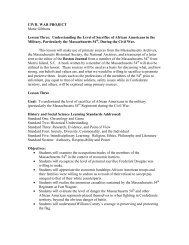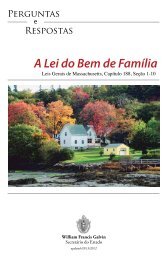Roads, Rails, and Trails - Secretary of the Commonwealth
Roads, Rails, and Trails - Secretary of the Commonwealth
Roads, Rails, and Trails - Secretary of the Commonwealth
Create successful ePaper yourself
Turn your PDF publications into a flip-book with our unique Google optimized e-Paper software.
The lower part <strong>of</strong> <strong>the</strong> pot was decorated using a<br />
technique called cord-marking, in which <strong>the</strong> not yet dry clay is<br />
pressed or beaten with a paddle wrapped with textile or cord.<br />
This creates a textured surface that is a bit easier to grip <strong>and</strong><br />
adds both visual <strong>and</strong> tactile interest. The neck <strong>and</strong> rim were<br />
decorated by stamping <strong>the</strong> still wet clay with a comb-like tool<br />
with closely-spaced triangular teeth. The potter made two<br />
b<strong>and</strong>s <strong>of</strong> parallel lines not quite perpendicular to <strong>the</strong> vessel rim.<br />
This vessel is roughly similar to vessels found on isl<strong>and</strong>s in<br />
Boston Harbor <strong>and</strong> on Martha’s Vineyard. It is markedly<br />
different from vessels from <strong>the</strong> same period found at sites<br />
around Narragansett Bay <strong>and</strong> <strong>the</strong> Taunton River. So it looks<br />
like this visit to <strong>the</strong> site was from people with connections to<br />
<strong>the</strong> east.<br />
What about <strong>the</strong> o<strong>the</strong>r pot? The one from Feature 8 that<br />
dated from <strong>the</strong> 1600s? That pot was very different. For one<br />
thing, <strong>the</strong> temper was not shell, but finely crushed rock, also<br />
known as “grit." The vessel was made by slab construction, in<br />
which a potter makes flat slabs <strong>of</strong> clay, sticks <strong>the</strong>m toge<strong>the</strong>r,<br />
<strong>and</strong> fuses <strong>the</strong>m by holding a stone or block <strong>of</strong> wood on <strong>the</strong><br />
inside <strong>and</strong> beating <strong>the</strong> outside with a paddle. The potter adds<br />
slabs <strong>and</strong> beats <strong>the</strong>m in until she has <strong>the</strong> size <strong>and</strong> shape vessel<br />
she wants. Archaeologists can recognize this construction<br />
technique by <strong>the</strong> way <strong>the</strong> sherds break along <strong>the</strong> seams <strong>of</strong> <strong>the</strong><br />
slabs. This was also a fairly small vessel; <strong>the</strong> mouth had a<br />
diameter <strong>of</strong> five <strong>and</strong> a half inches. It had thick walls around <strong>the</strong><br />
neck <strong>and</strong> rim, which thinned out a bit in <strong>the</strong> rounded body. The<br />
inside <strong>and</strong> outside surfaces <strong>of</strong> this vessel were smoo<strong>the</strong>d before<br />
it dried. The potter was especially careful to smooth it around<br />
<strong>the</strong> neck area before starting <strong>the</strong> final decorative procedure, in<br />
which she chose to cut wide, shallow grooves arranged in rows<br />
both parallel <strong>and</strong> diagonal to <strong>the</strong> rim. She also made small<br />
notches around <strong>the</strong> inside <strong>and</strong> outside <strong>of</strong> <strong>the</strong> rim.<br />
17<br />
This sherd is from a vessel dated to <strong>the</strong> 1600s. It has fine grit<br />
temper <strong>and</strong> was decorated by incising sets <strong>of</strong> lines around <strong>the</strong><br />
rim <strong>and</strong> neck <strong>of</strong> <strong>the</strong> vessel.<br />
These simple but graceful decorative motifs are<br />
common throughout sou<strong>the</strong>rn New Engl<strong>and</strong> <strong>and</strong> beyond during<br />
this period. Their meanings are not obvious; archaeologists<br />
cannot "read" anything as simple as tribal, village, or clan<br />
membership in pottery decorations. Each pot, humble or fancy,<br />
represents a unique event, in which a person, almost certainly a<br />
woman, made a vessel that had to function as a practical<br />
cooking pot but could also express something to those who saw<br />
it. To achieve this goal, she made a series <strong>of</strong> technical <strong>and</strong><br />
aes<strong>the</strong>tic choices, blending available clays <strong>and</strong> tempers,<br />
building <strong>the</strong> vessel, <strong>and</strong> treating or decorating <strong>the</strong> surface based<br />
on her knowledge <strong>of</strong> traditions, symbols, <strong>and</strong> meanings. When<br />
we look at one <strong>of</strong> those potsherds, we get an indirect glimpse<br />
into that world <strong>of</strong> humble function <strong>and</strong> subtle symbol. No<br />
wonder archaeologists like pottery so much!








